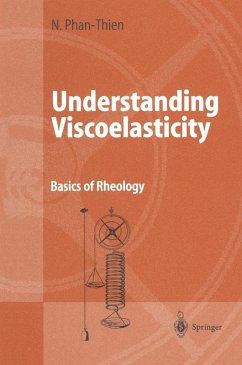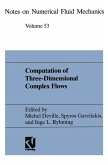Viscoelasticity (or rheology) is a highly mathematical subject, interfacing several disciplines, from applied mathematics to mechanics and engineering. Other books on rheology are usually comprehensive to such a degree that students find it hard to isolate the important physical principles and develop good analytical skills for solving useful engineering problems. In this book, the necessary background for understanding viscoelasticity is covered; both the continuum and microstructure approaches to modelling viscoelastic materials are discussed, since neither approach alone is sufficient. The book starts with tensor notation, to give students the basic working tools, then addresses kinematics and constitutive equations, and ends with the constitutive modelling of polymer solutions and suspensions. It also includes a series of problems of graded difficulty. It is self-contained and ideally suited for a one-semester course on viscoelasticity.
Dieser Download kann aus rechtlichen Gründen nur mit Rechnungsadresse in A, B, BG, CY, CZ, D, DK, EW, E, FIN, F, GR, HR, H, IRL, I, LT, L, LR, M, NL, PL, P, R, S, SLO, SK ausgeliefert werden.
From the reviews:
"In Understanding Viscoelasticity: Basics of Rheology, Nhan Phan-Thien, who has produced several substantial contributions in rheology over the past three decades, provides a concise account of the behavior of real materials . . . Suitable as a text for a first-year graduate course in viscoelastic materials, the book provides students with some necessary tools to read and better understand technical articles in the field . . . Among the book's many positive attributes are the clear introductory remarks that begin each chapter. Concepts leading to material functions are well introduced and defined. Nice historical tidbits, sprinkled throughout, convey valuable information on scientists of note and the remarkable scientific advances for which they are famous. Homework problems with ample pedagogical and mnemonic value appear at the end of each chapter . . . Understanding Viscoelasticity is a joy to read and will be very useful to motivated students."
PHYSICS TODAY
"In this small textbook a brief introduction into the rheological branch of viscoelasticity is given. ... In contrast to other monographies in rheology, the present one results from lecture notes of a short introductory course ... . some interesting historical notes on the pioneers of rheology are given. The book can be recommended as a first introduction into the matter ... ." (Technische Mechanik, Vol. 25 (2), 2005)
"This book is a good introduction to the theory of viscoelasticity. The author presents the fundamentals of continuum mechanics together with mathematical background in a unified description. ... The book gives a detailed and clear treatment of the subject. Each chapter contains interesting problems. On balance, this is a useful work." (Dorin Iesan, Zentralblatt MATH, Vol. 1036 (11), 2004)
"Suitable as a text for a first-year graduate course in viscoelastic materials, the book provides students with some necessary tools toread and better understand technical articles in the field. ... Among the book's many positive attributes are the clear introductory remarks that begin each chapter. Concepts leading to material functions are well introduced and defined. Nice historical tidbits, sprinkled throughout, convey valuable information ... . Understanding Viscoelasticity is a joy to read and will be very useful to motivated students." (Daniel De Kee, Physics Today, July, 2003)
"In Understanding Viscoelasticity: Basics of Rheology, Nhan Phan-Thien, who has produced several substantial contributions in rheology over the past three decades, provides a concise account of the behavior of real materials . . . Suitable as a text for a first-year graduate course in viscoelastic materials, the book provides students with some necessary tools to read and better understand technical articles in the field . . . Among the book's many positive attributes are the clear introductory remarks that begin each chapter. Concepts leading to material functions are well introduced and defined. Nice historical tidbits, sprinkled throughout, convey valuable information on scientists of note and the remarkable scientific advances for which they are famous. Homework problems with ample pedagogical and mnemonic value appear at the end of each chapter . . . Understanding Viscoelasticity is a joy to read and will be very useful to motivated students."
PHYSICS TODAY
"In this small textbook a brief introduction into the rheological branch of viscoelasticity is given. ... In contrast to other monographies in rheology, the present one results from lecture notes of a short introductory course ... . some interesting historical notes on the pioneers of rheology are given. The book can be recommended as a first introduction into the matter ... ." (Technische Mechanik, Vol. 25 (2), 2005)
"This book is a good introduction to the theory of viscoelasticity. The author presents the fundamentals of continuum mechanics together with mathematical background in a unified description. ... The book gives a detailed and clear treatment of the subject. Each chapter contains interesting problems. On balance, this is a useful work." (Dorin Iesan, Zentralblatt MATH, Vol. 1036 (11), 2004)
"Suitable as a text for a first-year graduate course in viscoelastic materials, the book provides students with some necessary tools toread and better understand technical articles in the field. ... Among the book's many positive attributes are the clear introductory remarks that begin each chapter. Concepts leading to material functions are well introduced and defined. Nice historical tidbits, sprinkled throughout, convey valuable information ... . Understanding Viscoelasticity is a joy to read and will be very useful to motivated students." (Daniel De Kee, Physics Today, July, 2003)









